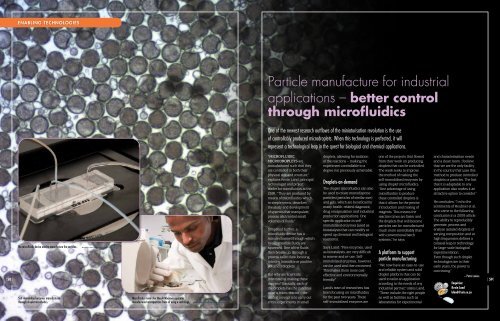Research and development for industry: Advanced ... - CSIR
Research and development for industry: Advanced ... - CSIR
Research and development for industry: Advanced ... - CSIR
You also want an ePaper? Increase the reach of your titles
YUMPU automatically turns print PDFs into web optimized ePapers that Google loves.
ENABLING TECHNOLOGIESParticle manufacture <strong>for</strong> industrialapplications – better controlthrough microfluidicsOne of the newest research outflows of the miniaturisation revolution is the useof controllably produced microdroplets. When this technology is perfected, it willrepresent a technological leap in the quest <strong>for</strong> biological <strong>and</strong> chemical applications.| 58 |The microfluidic device used to manufacture the particles.Self-immobilised enzymes manufacturedthrough droplet microfuidics.Microfluidics researcher Mesuli Mbanjwa separatesmanufactured microparticles from oil using a centrifuge.“Microfluidicmicrodroplets aremanufactured such that theyare controlled in both theirphysical size <strong>and</strong> structure,”explains Kevin L<strong>and</strong>, principaltechnologist <strong>and</strong> projectleader <strong>for</strong> microfluidics at the<strong>CSIR</strong>. “They are produced bymeans of microfluidics which,in simple terms, describesthe study <strong>and</strong> <strong>development</strong>of systems that manipulate,process <strong>and</strong> control smallvolumes of fluids.”Simplified further, amicrofluidic device has aminute channel through whichtwo immiscible fluids aresqueezed. One of the fluidsthen breaks up, through aprocess called flow focusing,into tiny (nanolitre or picolitrevolumes) droplets.But why are scientistsinterested in making thesedroplets? Basically, each ofthe droplets has the potentialto be a micro-reactor – thecentral concept is to carry outentire experiments in smalldroplets, allowing <strong>for</strong> isolationof the reactions – making theexperiment controllable to adegree not previously achievable.Droplets-on-dem<strong>and</strong>The droplet microfluidics can alsobe used to create monodisperseparticles (particles of similar size)<strong>and</strong> gels, which are beneficial <strong>for</strong>many health-related diagnostic,drug encapsulation <strong>and</strong> industrialproduction applications. Onespecific application is selfimmobilisedenzymes (used asbiocatalysts that can modify orspeed up chemical <strong>and</strong> biologicalreactions).Says L<strong>and</strong>: “Free enzymes, usedas biocatalysts, are very difficultto recover <strong>and</strong> re-use. Selfimmobilisedenzymes, however,can be used <strong>and</strong> then recovered.This makes them more costeffective<strong>and</strong> environmentallyfriendly.”L<strong>and</strong>’s team of researchers hasbeen focusing on microfluidics<strong>for</strong> the past two years. Theseself-immobilised enzymes areone of the projects that flowedfrom their work on producingdroplets that can be controlled.The work seeks to improvethe method of making theself-immobilised enzymes byusing droplet microfluidics.“One advantage of usingmicrofluidics to producethese controlled droplets isthat it allows <strong>for</strong> the preciseintroduction <strong>and</strong> mixing ofreagents. This means thereaction times are faster <strong>and</strong>the droplets that will becomeparticles can be manufacturedmuch more controllably thanwith conventional batchsystems,” he says.A plat<strong>for</strong>m to supportparticle manufacturing“We now have an easy-to-use<strong>and</strong> reliable system <strong>and</strong> soliddroplet plat<strong>for</strong>m that can beused to tailor an applicationaccording to the needs of anyindustrial partner,” states L<strong>and</strong>.“These include the right peopleas well as facilities such aslaboratories <strong>for</strong> experimental<strong>and</strong> characterisation needs<strong>and</strong> a clean room. I believethat we are the only facilityin the country that uses thismethod to produce controlleddroplets or particles. The factthat it is adaptable to anyapplication also makes it anattractive option to consider.”He concludes: “I echo thesentiments of Heubner et al,who came to the followingconclusion in a 2008 article:The ability to reproduciblygenerate, process <strong>and</strong>analyse isolated droplets ofvarying composition <strong>and</strong> athigh frequencies defines acolossal leap in technology<strong>for</strong> large-scale biologicalexperimentation.Even though such droplettechnologies are in theirearly years, the power isconvincing.”– Petro LowiesEnquiries:Kevin L<strong>and</strong>kl<strong>and</strong>@csir.co.za| 59 |
















